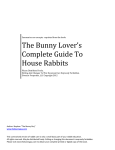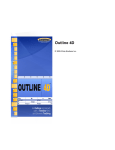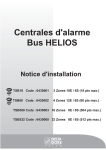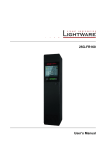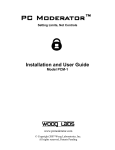Download WS LSCB GCP User Manual - West Sussex Safeguarding Children
Transcript
Graded Care Profile User Manual With thanks to Dr O P Srivastava for kindly allowing West Sussex LSCB to use the Graded Care Profile Page 1 of 8 Grades In this scale there are five grades based on levels of commitment to care. Parallel with the level of commitment is the degree to which a child’s needs are met and which also can be observed. The basis of separation of different grades is outlined in the table below. Grade 1. Grade 2. Grade 3. Grade 4. Grade 5. 1 All child’s needs met Essential needs fully met Some essential needs unmet Most essential needs unmet Essential needs entirely unmet/ hostile 2 Child first Child first, most of the time. Child/carer at par Child second Child not considered 3 Best Adequate Borderline Poor Worst 1. = level of care; 2 = commitment to care; 3 = quality of care These grades are then applied to each of the four areas of need, based on Maslow’s hierarchy of needs – physical, safety, love and esteem This model was adopted not so much for its hierarchical nature but for its comprehensiveness. Each area is broken down into sub-areas, and some sub-areas to items, for ease of observation. An explanatory table shows all the areas and sub-areas with the five grades alongside. Maslow's hieracrhy of needs To obtain a score, follow the instructions in this manual. The explanatory tables give brief examples of care in all sub-areas/items for all the five grades. From these, scores for the areas are decided. Instructions The Graded Care Profile (GCP) gives an objective measure of care of a child by a carer. It gives a qualitative grading for actual care delivered to a child taking account of commitment and effort shown by the carer. Personal attributes of the carer, social environment or attributes of the child are not accounted for unless actual care is observed to be affected by them. Thus, if a child is provided with good food, good clothes and a safe house the GCP will score better irrespective of the financial situation. The grades are on a 1 – 5 scale. Grade one is the best and five the worst. This grading is based on how the carer(s) responds to the child’s needs. This is applied in four areas of need – physical, safety, love and esteem. Each area is made up of different sub-areas and some sub-areas are further broken down into different items of care. The score for each area is made up of scores obtained for its items. An explanatory table is prepared giving brief examples of levels of care for the five grades against each item or sub-area of care. Scores are obtained by matching information elicited in a given case with those in the explanatory table. This is taken advantage of in designing Page 2 of 8 the follow-up and targeting intervention. Methods are described below in detail. It can be scored by the carers/s themselves if need be or practicable. How it is organised. It has three main components, which are described below: 1. The explanatory table is laid out in areas, sub areas and items There are four ‘areas’ – physical, safety, love and esteem which are labelled as – A, B, C and D respectively. Each area has its own ‘sub areas’, which are labelled numerically – 1, 2, 3, 4 and 5. Some of the ‘sub areas’ are made up of different ‘items’ which are labelled as – a, b, c, d. Thus the unit for scoring is an ‘item’ (or a ‘sub-area’ where there are no items). The table below shows Area A (physical), sub-area 1 (nutrition) and item a (quality). A Area of physical care 1. child priority 2 child first 3 child and carer equal 4 child second 5 child not considered Aware and thinks ahead; provides excellent quality food and drink. Aware and manages to provide reasonable quality food and drink. Provision of reasonable quality food, inconsistent through lack of awareness or effort. Provision of poor quality food through lack of effort; only occasionally of reasonable quality if pressurised. Quality not a consideration at all or lies about quality. 1 Nutrition Quality For some of the sub-areas or items there are age bands written in bold italics. Stimulation, a sub-area of the area ‘esteem’, is made up of ‘sub-items’ for age bands 0–2, 2–5 & above 5 years. Clearly, only one will apply in any case. 2. The scoring sheet There is a scoring sheet, which accommodates the entire system down to the items. It gives an overview of all scores and should be completed as the scores are decided from the explanatory table. AREAS Sub areas A PHYSICAL NUTRITION 1 Items a b quality quantity c preparation 3. The summary sheet Page 3 of 8 d organisation It is printed on an A4 sheet. At the top there is room to make note of personal details, date and to note who the main carer is about whom the scoring is done. ‘Areas’ and ‘sub-areas’ are in a column vertically on the left hand side and scores (1 to 5) in a row of boxes horizontally against each sub-area. Next to this is a rectangular box for noting the overall score for the area, which is worked from the scores in sub-areas (described later). Next to the area score, there is another box to accommodate any comments relating to that area. At the bottom there is a separate table designed to target sub-area(s) or item(s) where care is particularly deficient and to follow them up. Physical A Area Sub Area Scores Area Score 1. Nutrition 1 2 3 4 5 2. Housing 1 2 3 4 5 3. Clothing 1 2 3 4 5 4. Hygiene 1 2 3 4 5 5. Health 1 2 3 4 5 Comments Workers who have used this say that although it looks complicated at first, it gets easier once familiar with the tool How to use 1. Discuss with the parent or carer your wish to complete a GCP with them. Go through the parents’ leaflet with them and leave them a copy. Once you are sure they have understood, ask them to sign the consent form on the summary sheet. Fill in the relevant details at the top of the record sheet. Keep the form for your records and note that consent has been given in your case recording system. 2. The Main Carer: is the main carer present when you do the graded care profile. It can be either or both parents, or another main carer. Note who is involved in the top right corner of the record sheet. 3. Methods: It is necessary to do a home visit to make observations. You need to be familiar with the area headings to be sure everything is covered during one or more visits. This document can be shared with the family during the visit, or you can fill it in afterwards. Carers using it themselves can simply go through the explanatory table. 4. Situations: a) As far as possible, use the usual state of the home environment and don’t worry about any short term, smaller upsets e.g. no sleep the night before. b) Don’t take into account any external factors on the environment (e.g. house refurbished by welfare agency) unless carers have positively contributed in some way by keeping it clean, adding their own bits in the interest of the child like a safe garden, outdoor or indoor play equipment or safety features etc. c) Allowances should be made for background factors, e.g. bereavement, recent loss of job, illness in parents. It may be necessary to revisit and score at another time. d) If the carer is trying to mislead deliberately by giving the wrong impression or information in order to make one believe otherwise- score as indicated in the explanatory table. (e.g. ‘misleading explanations’- for PHYSICAL Health/follow up would score 5. and ‘any warmth/guilt not genuine’ for LOVE Carer/reciprocation would score 5). Page 4 of 8 5. Once completed, share a copy with the parents with whom you have completed it and ask them to sign to say they have seen the completed profile. Send them a copy as soon as possible. Obtaining information on different items or sub-areas: A) Physical 1. Nutritional: (a) Quality (b) Quantity (c) Preparation and (d) Organisation Take a history about the meals provided including nutritional contents (milk, fruits etc.), preparation, set meal times, routine and organisation. Also note carer’s knowledge about nutrition, note carer’s reaction to suggestions made regarding nutrition (whether keen and accepting or dismissive). Observe for evidence of provision, kitchen appliances and utensils, dining furniture and its use without being intrusive. It is important not to lead as far as possible but to observe the responses carefully for honesty. Observation at a mealtime in the natural setting (without special preparation) is particularly useful. Score on amount offered and the carer’s intention to feed younger children rather than actual amount consumed as some children may have eating/feeding problems. 2. Housing: (a) Maintenance (b) Décor (c) Facilities Observe. If lacking, ask to see if effort has been made to improve, ask yourself if carer is capable of doing them him/herself. It is not counted if repair or decoration is done by welfare agencies or landlord. 3. Clothing: (a) Insulation (b) Fitting (c) Look Observe. See if effort has been made towards repairing, cleaning and ironing. Refer to the age band in the explanatory table. 4. Hygiene: Child’s appearance (hair, skin, behind ears and face, nails, rashes due to long term neglect of cleanliness, teeth). Ask about daily routines. Refer to age band in explanatory table. 5. Health (a) Opinion sought (b) Follow-up (c) Health checks and immunisation (d) Disability/ Chronic illness Ask who is consulted on matters of health, and who decides when health care is needed. Check about immunisation uptake, reasons for non-attendance if any, see if reasons are valid. Check with relevant professionals. Distinguish genuine difference of opinion between carer and professional from non-genuine misleading reasons. Beware of being over sympathetic with carer if the child has a disability or chronic illness. Remain objective. B) Safety 1. In Presence: (a) Awareness (b) Practice (c) Traffic (d) Safety features This means how safely the home environment is organised. It includes safety features and carer’s behaviour regarding safety (e.g. lit cigarettes, drugs or medication left lying in the vicinity of child) in every day activity. Awareness may be assumed from the presence and appropriate use of safety fixtures and equipment in and around the house or in the car (child safety seat etc.) by observing carers handling of young babies and supervision of toddlers. Also observe how carer instinctively reacts to the child being exposed to danger. If observation not possible, then ask about the awareness. Observe or ask about child being allowed to cross the road, play outdoors etc. along the lines in this manual. If possible check answers out with other sources. Refer to the age band where indicated. 2. In Absence: This covers childcare arrangements where the carer is away, taking account of reasons and period of absence and age of the minder. This itself could be a matter for concern in some cases. Check answers out with other sources. Page 5 of 8 C) Love 1. Carer (a) Sensitivity (b) Timing of response (c) Reciprocation (quality of response) This mainly relates to the carer’s relationship with the child. Sensitivity means where carer shows awareness of any signal from the child. Carer may become aware yet respond a little later in certain circumstances. Note the timing of the carer’s response in the form of appropriate action in relation to the signal from the child. Reciprocation means the emotional quality of the response. 2. Mutual Engagement (a) Beginning interactions (b) Quality Observing what goes on between the carer and child during feeding, playing and other activities gives you a sense of whether both are actively engaged. Observe what happens when the carer and the child talk, touch, seek each other out for comfort and play, babies reaching out to touch while feeding or stop feeding to look and smile at the carer. Skip this part if child is known to have behavioural problems as it may become unreliable. Contact between carer and child that is unplanned is the best opportunity to observe these items. See if carer spontaneously talks to the child or responds when the child talks or makes noises. Note who gets pleasure from this, the carer and the child, either or neither. Note if it is play or functional (e.g. feeding etc.). D) Esteem 1. Stimulation: Observe or enquire how the child is encouraged to learn. Talking and making noises, interactive play, nursery rhymes or joint story reading, learning social rules, providing fun play equipment are such examples with infants (0 – 2 years). If lacking, try to note if it was due to carer being occupied by other essential chores. Follow the explanatory table for appropriate age band. The four elements (i, ii, iii and iv) in age band 2-5 years and 5- years provide a comprehensive picture. Score in one of the items is enough. If more items are scored, score for whichever column describes the case best. In the event of a tie choose the higher score (also described in the explanatory table). 2. Approval: Find out how child’s achievement is rewarded or neglected. It can be assessed by asking how the child is doing or simply by praising the child and noting the carer’s response (agrees with delight or child’s successes rejected or put down) 3. Disapproval: If opportunity presents, observe how the child is told off, otherwise enquire carefully (Does the child throw tantrums? How do you deal with it if it happens when you are tired yourself?) Beware of any difference between what is said and what is done. Any observation is better in such situations than the carer’s description e.g. child being ridiculed or shouted at. Try and ask more if carer is consistent. 4. Acceptance: Observe or ask how carer generally feels after she/he has told the child off, or when the child has been told off by others (e.g. teacher), when child is not doing well, or feeling sad for various reasons. See if the child is rejected (put down) or accepted at these times with warm and supportive behaviour. Scoring on the explanatory table Make sure your information is factual as far as possible. Go through explanatory table – (Sub-Areas and Items). Find the description which matches best, read one grade on either side to make sure, then place a tick on that description (photocopy the score sheet to use each time). The number at the top of the column will be the score for that item or subarea. Where more than one item represents a sub-area, use the method described below to obtain the score for the sub-area. Obtaining a score for a sub-area from its items’ scores: Transfer the scores from the explanatory table to the scoring sheet for the items (and sub areas without items i.e. Page 6 of 8 hygiene). Read the score for all the items of a particular sub-area: if there is a clearly repeated number but none of the ticks are beyond 3, score that number for that particular sub-area. To record it on the scoring sheet enter the number in the box for that sub-area. Example: the scores for the items average 2 so the sub area score is 2. AREAS A PHYSICAL 1 Sub areas Items 2 NUTRITION a b b b 2 2 3 2 quality quantity preparation organisation If there is even a single score of 4 or 5, score that point regardless of other scores. Example: the scores for the items average 3, but there is a score of 4, so the sub area score is 4. AREAS A PHYSICAL Sub areas 1 NUTRITION 4 Items a b c d 2 4 3 3 quality quantity preparation organisation Obtaining a score for an area: Follow the same principle for getting an overall score for an area by taking an average of the sub-area scores. Again, if there is even a single score of 4 or 5, score that point regardless of other scores. This method helps identify the problem even if it is one sub-area or item. Its primary aim is to safeguard child’s welfare while being objective. The average score is not used as it will not show up the high scores which are the areas of concern. Transferring the scores to the summary sheet: Transfer all scores in double boxes from the scoring sheet to the summary sheet. This will be the sub area and area scores. Comments: This column in the summary sheet can be used for flagging up issues, which are not detected by the profile but may be relevant in a particular case. For example, a child whose behaviour is difficult or a parent whose over protectiveness gives rise to concern. Comments noted may then lead to additional support. Targeting: If a particular sub-area scores highly, it can be noted in the table at the bottom of the summary sheet. A better score can be aimed at after a period of work. Aiming for Page 7 of 8 one grade better will place less demand on the carer than by aiming for the ideal in one leap. A GCP score is always in the context of a specific carer in relation to a specific child. Thus, if a single mother has learning disability and there is concern that she cannot care for her child then a GCP scoring should be done where possible and then her level of learning disability ascertained. Each (GCP & level of learning disability) need to be juxtaposed to get a fuller picture. If her grades of care are on positive side, then there may still be risk if learning disability is severe as it may still affect the care in more demanding situations and a view needs to be made how much and how long support she will need. On the other hand if learning disability is mild to moderate she may do well with some supervision as and when needed. However, if the GCP is on negative side in all areas then it may be better to follow it through a child protection plan even if learning disability is mild. Thus a number of different combinations can be found, each representing a different level of risk of harm to guide management before and after referral to the social care. A completed score displayed on a Record Sheet shows a grade of care in each of four domains on one side and their constituent items or sub-areas on the other side. There is also a table to select area/s where care is deficient to target for intervention and track. Where the profile is uneven, eg negative in two areas and positive in the rest, they denote different levels of care neglect. 1. Uniformly positive: Positive (1 or 2) in all areas – currently no concern, child well cared for. 2. Uneven: Positive in some and negative in others – it can be worked on, using positive care as motivator. 3. Uniformly negative (4 or 5) in all areas – this signifies significant neglect. The GCP has been used in Luton since 1999 approved by the Luton Areas Child Protection Committee. It was used at a professionals’ discretion. A user evaluation was undertaken five years after its use in 2004. Of 73 who were trained 33 (45%) had been using it; of these 24 (73%) had used it serially to monitor the progress and 22 (92%) of these found it useful. Majority (30; 91%) of professionals scored it with carer’s agreement – 6 (20%) reported no disagreement with carer on the scores whereas 21 (70%) reported initial disagreement in some of the cases and 2 (7%) in all the cases. Of these 26 (87%) scored jointly with carers. In addition 17 of 33 users (52%) reported it to be more objective than if they would have estimated it themselves; 20 (61%) reported that it helped engage with the carers; 17 (52%) reported it helped measure progress in small increments and the same proportion reported it helped target intervention. Of 33 users 28 (85%) reported it captured physical and emotional neglect (5 did not reply) and 23 (70%) reported it also captured neglect of developmental needs (Srivastava O.P, Stewart J, Fountain R, & Ayer P; 2004). Page 8 of 8









